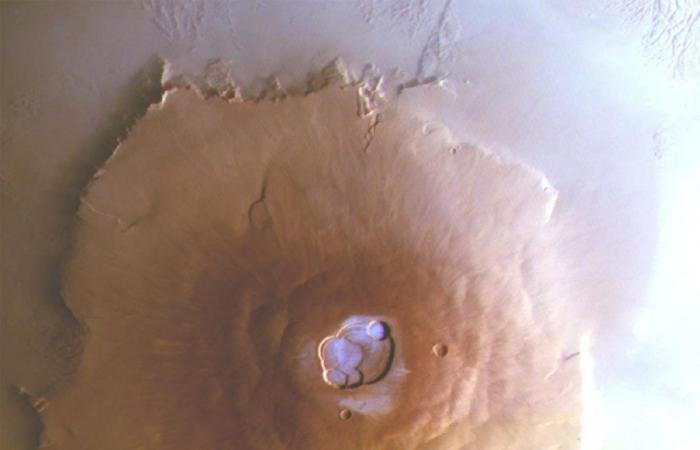The scene was captured by chance from Martian orbit by the Trace Gas Orbiter (TGO) probe of the European Space Agency (ESA), in the Tharsis dome (volcanic region), near the equator of Mars, described a study published Monday in Nature Geosciences.
It is a vast elevated region, approximately 5,000 km in diameter, housing immense volcanoes, extinct for millions of years. Among them, the largest in the solar system, Olympus Mons and its 22,000 m high, three times Everest.
No one expected to find frost there. “We thought it was impossible around the equator of Mars,” summarizes Adomas Valantinas, the first author of the study behind the discovery.
Strong sunshine and very low atmospheric pressure “keep temperatures at a fairly high level at the summits and on the surface,” explains this researcher at Brown University in the United States, in an ESA press release. In the Tharsis region, temperatures can drop very low, down to -130°C at night, but they do not depend on altitude, “unlike what happens on Earth, where we expect to see frozen summits,” he analyzes.
The atmosphere of the Martian equator is, moreover, particularly low in water, and makes condensation difficult. “Other probes had observed frost but in wetter regions, notably the northern plains,” Frédéric Schmidt, professor at Paris-Saclay University, one of the authors of the study, explains to AFP.
A natural witness to the history of the planet
The ExoMars team’s TGO probe, which has been orbiting Mars since 2018, records images and the discovery was fortuitous: “We saw a shiny and blue deposit, a particular texture that we only see in the early morning and in the cold seasons,” he says.
You had to have a keen eye as the ice deposit is thin and the phenomenon is stealthy. However, the amount of frost present at the summits of four volcanoes (Olympus Mons, Ascraeus Mons, Arsia Mons and Ceraunius Tholus) represents “150,000 tonnes of water circulating between the surface and the atmosphere each day, the equivalent of 60 Olympic swimming pools,” comments the ESA.
Researchers explain this phenomenon by the existence of a micro-climate inside the calderas (vast circular crater) of the volcanoes. The winds would move up the slopes of the mountains, “bringing relatively humid air close to the surface to higher altitudes, where it condenses and is deposited in the form of frost,” says Nicolas Thomas, co-author of the study. .
Modeling the process of frost formation should allow us to better understand the water cycle, which is “one of the best-kept secrets” of the Red Planet, according to the ESA.
The ambition to exploit the resources is already there. “We could recover water from the frost for human consumption, and launch rockets from Mars by separating the oxygen and hydrogen molecules,” anticipates Professor Schmidt.






